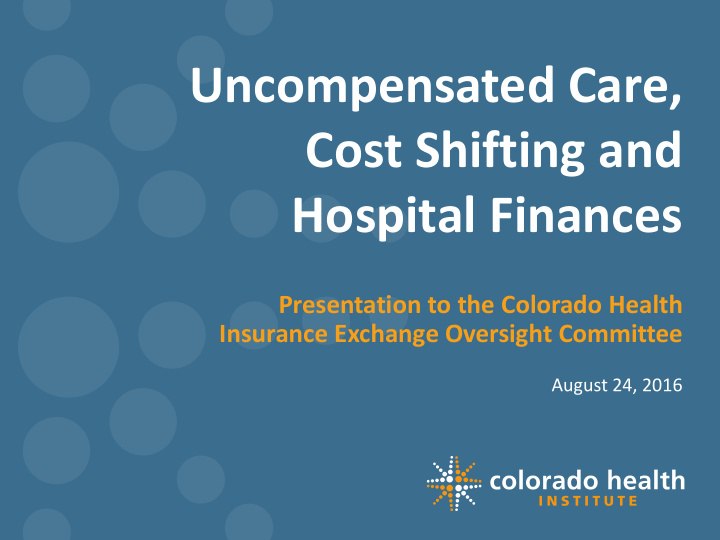



Uncompensated Care, Cost Shifting and Hospital Finances Presentation to the Colorado Health Insurance Exchange Oversight Committee August 24, 2016
Setting the Stage The questions CHI was asked to address: With fewer uninsured Coloradans, how much has uncompensated care declined? How has this impacted commercial hospital prices? 2
Question 1: What is uncompensated care? • Uncompensated care is the cost of care for which no payment was received from the patient or insurer. • Uncompensated care = Charity Care + Bad Debt • Uncompensated care is different than undercompensated care, which is the cost of care that is underpaid by programs like Medicare and Medicaid. • Some uncompensated care may be paid indirectly by government sources. 3
Question 2: How has uncompensated care changed over time? Colorado Hospitals' Uncompensated Care $800 $700 $600 $500 Million $400 $300 $200 $100 $0 2009 2010 2011 2012 2013 2014 Sources: HCPF and the Hospital Provider Fee Oversight and Advisory Board Annual Report on the Colorado Health Care Affordability Act (Jan. 2016), supplemented by data from the Colorado Hospital Association 4
Question 3: What is cost shifting, and does it exist in hospital markets? Cost shifting: Inadequate reimbursement by certain payers forces providers to recoup losses by charging higher prices to other payers. 5
What is price discrimination? Price discrimination: When suppliers of goods and services charge different prices to customers based on their willingness to pay. • Different prices for college students and senior citizens at restaurants. • Lower price for children’s movie tickets.
Empirical evidence of cost shifting • Nationally in 2013, $21 billion in uncompensated care amounts to 2.3% of private insurance spending. (Urban Institute/Kaiser) • In Colorado in 2013, the $700 million in uncompensated care amounts to about 4% of private insurance spending. 7
Question 4: How has payment relative to cost changed over time? Payment to provider/ Cost of patient
Payment to Cost Ratios: 2009 - 2014 Payment to Cost Ratio
How Has Payment Changed Over Time? Average Payment
How Have Costs Changed Over Time? Average Costs
Question 5: What can drive cost increases? • Patient complexity • Care utilization • Technology • Administration • Capital construction 12
Conclusions • There is mixed evidence that a cost shift exists in hospital markets. • Compared with private health insurance spending, the amount of uncompensated care is relatively small. • Since passage of the Affordable Care Act, both payments and costs have gone up. 13
Amy Downs 720.382.7091 downsa@coloradohealthinstitute.org Amy (Vice President) manages CHI’s analytical portfolio. She has expertise in health care cost drivers and evaluating payment and insurance reforms. During her 11 years at CHI, she has led a number of modeling projects measuring the impacts of different policy options on the health care sector. Edmond Toy 720.382.7080 toye@coloradohealthinstitute.org Edmond (Director) is an economist and health policy expert with over 15 years of experience in both public and private sectors. He previously served on the staff of the White House Office of Management and Budget and worked for an economic and strategy consulting firm. Edmond holds a bachelor’s degree from Stanford University, an MS from the Massachusetts Institute of Technology and a PhD in Health Policy from Harvard University. 14
Recommend
More recommend